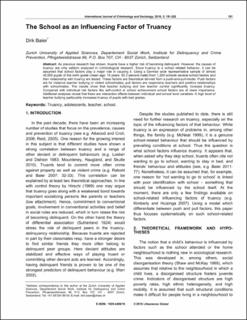Please use this identifier to cite or link to this item:
https://doi.org/10.21256/zhaw-2761Full metadata record
| DC Field | Value | Language |
|---|---|---|
| dc.contributor.author | Baier, Dirk | - |
| dc.date.accessioned | 2019-01-11T12:42:35Z | - |
| dc.date.available | 2019-01-11T12:42:35Z | - |
| dc.date.issued | 2016 | - |
| dc.identifier.issn | 1929-4409 | de_CH |
| dc.identifier.uri | https://digitalcollection.zhaw.ch/handle/11475/14383 | - |
| dc.description.abstract | As previous research has shown, truants have a higher risk of becoming delinquent. However, the causes of truancy are only seldom analyzed in criminological research. Since truancy is a school related behavior, it can be assumed that school factors play a major role in causing it. Using a German wide representative sample of almost 40,000 pupils of the ninth grade (mean age: 15 years; 50.3 percent male) from 1,200 schools several school factors and their relationship with truancy are tested. These factors are theoretical derived from a push-and-pull-model. Push factors are for instance teacher bullying or violent schoolmates, pull factors are responsive teachers and positive relationships with schoolmates. The results show that teacher bullying and low teacher control significantly increase truancy. Compared with individual risk factors like self-control or school achievement school factors are of lower importance. Additional analyses reveal that there are interaction effects between individual and school level variables: A high level of teacher bullying particularly increases truancy of pupils with bad grades. | de_CH |
| dc.language.iso | en | de_CH |
| dc.publisher | Lifescience Global | de_CH |
| dc.relation.ispartof | International Journal of Criminology and Sociology | de_CH |
| dc.rights | http://creativecommons.org/licenses/by-nc/3.0/ | de_CH |
| dc.subject.ddc | 371: Schulen und schulische Tätigkeiten | de_CH |
| dc.title | The school as an influencing factor of truancy | de_CH |
| dc.type | Beitrag in wissenschaftlicher Zeitschrift | de_CH |
| dcterms.type | Text | de_CH |
| zhaw.departement | Soziale Arbeit | de_CH |
| zhaw.organisationalunit | Institut für Delinquenz und Kriminalprävention (IDK) | de_CH |
| dc.identifier.doi | 10.21256/zhaw-2761 | - |
| dc.identifier.doi | 10.6000/1929-4409.2016.05.18 | de_CH |
| zhaw.funding.eu | No | de_CH |
| zhaw.originated.zhaw | Yes | de_CH |
| zhaw.pages.end | 202 | de_CH |
| zhaw.pages.start | 191 | de_CH |
| zhaw.publication.status | publishedVersion | de_CH |
| zhaw.volume | 5 | de_CH |
| zhaw.publication.review | Peer review (Publikation) | de_CH |
| zhaw.webfeed | Jugendkriminalität und Jugendgewalt | de_CH |
| Appears in collections: | Publikationen Soziale Arbeit | |
Files in This Item:
| File | Description | Size | Format | |
|---|---|---|---|---|
| 2016_Baier_School as influencing factor of truancy_IJCS.pdf | 266.82 kB | Adobe PDF |  View/Open |
Show simple item record
Baier, D. (2016). The school as an influencing factor of truancy. International Journal of Criminology and Sociology, 5, 191–202. https://doi.org/10.21256/zhaw-2761
Baier, D. (2016) ‘The school as an influencing factor of truancy’, International Journal of Criminology and Sociology, 5, pp. 191–202. Available at: https://doi.org/10.21256/zhaw-2761.
D. Baier, “The school as an influencing factor of truancy,” International Journal of Criminology and Sociology, vol. 5, pp. 191–202, 2016, doi: 10.21256/zhaw-2761.
BAIER, Dirk, 2016. The school as an influencing factor of truancy. International Journal of Criminology and Sociology. 2016. Bd. 5, S. 191–202. DOI 10.21256/zhaw-2761
Baier, Dirk. 2016. “The School as an Influencing Factor of Truancy.” International Journal of Criminology and Sociology 5: 191–202. https://doi.org/10.21256/zhaw-2761.
Baier, Dirk. “The School as an Influencing Factor of Truancy.” International Journal of Criminology and Sociology, vol. 5, 2016, pp. 191–202, https://doi.org/10.21256/zhaw-2761.
Items in DSpace are protected by copyright, with all rights reserved, unless otherwise indicated.